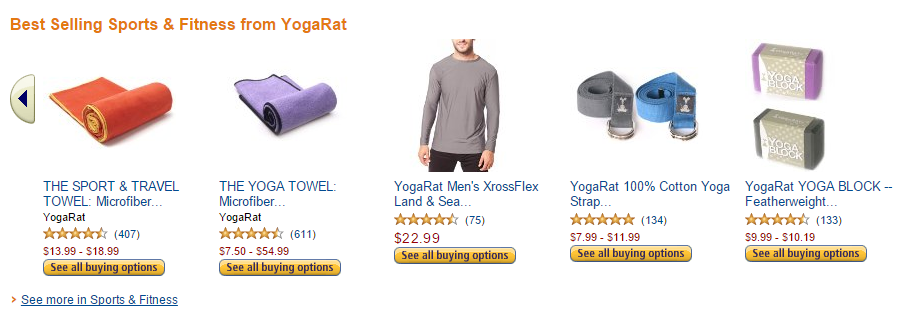Financing Strategy for Amazon Sellers – Best Tips from YogaRat

Before finding immense success on Amazon with his company YogaRat, Wendell Morris was also an Emmy-winning writer. The Santa Monica native and yoga enthusiast decided in 2007 to venture beyond his writing capabilities and into the world of ecommerce to sell his own line of yoga mats, bags, towels and more.
Since YogaRat’s official launch on Amazon in 2009, Wendell says his company has doubled in daily sales nearly every year.
We spoke with Morris about how he was able to raise the initial capital and his financing strategy to build a successful brand.
A. No, but I made an independent feature film, which I financed and sold on my own. That was my first entrepreneurial experience. It taught me a lot about business, mostly that you don’t necessarily have to be an expert to start something and make a go of it. You can literally say “I’m going to start a business,” and then do it.
That fueled my work at YogaRat, because business is often about being adaptable and responsive to what comes at you, as you implement strategy and grow. After the business was up and running I was accepted into the Goldman Sachs 10,000 Small Businesses program, which teaches and supports small business owners across the country, and that has helped me a lot.
A. YogaRat sold its first yoga mats in 2009. Since the vast majority of yoga mat factories are located overseas, I started by talking with multiple factory representatives by email. I asked every question I could, communicating with some representatives for about a year, until I knew everything I could about different types of yoga mats and their manufacturing processes.
I then made a trip out to Asia, and visited the factories I had conversations with, checking their operations and making sure they treated their workers well.
After I returned home, I chose the factories and people I wanted to work with. I’m still working with the ones I started with. So while I said “I’m going to start a business,” I also did my homework.

A. I knew nothing about it. First thing we did was build our own YogaRat.com website, then not too long after we started selling on Amazon. Once we started selling on Amazon, our online sales really started to move.
Its platform is so robust, and their team is so helpful, that it takes a lot of the work off your shoulders. They are always making the systems better.
That’s not to say it’s easy. If you want to sell on Amazon and grow your business you have to do a lot of homework as well, but it’s homework that pays off.
A. When the company first started I was handling all of the logistics, paperwork and sales myself. I also didn’t pay myself a salary for the first three years of operation, because the business could not support it. I was freelance writing while managing and growing the business.
Likewise, when you are an unproven business it’s very difficult to find sources of working capital to purchase inventory and get orders started at factories.
I had to be very creative in figuring out not only how to grow the business, but also how to find the working capital necessary to keep it growing.
That meant knocking on doors of friends and family to borrow money. I had to get over my reluctance to ask for help, and make good on my promises to those who were kind enough to lend.
That was probably the most difficult time for me, but starting a business takes some sacrifices, and you have to learn to play the cards you are dealt well.
No matter the cards you still have to figure out how to win, and with every victory you gain a little more confidence to reach a little farther.

A. At the beginning of the business raising capital was my most important task. Unless someone has a money tree to start their business with, there is very little help outside of friends and family to get their business started, at least for me. A year prior to incorporation, I studied up on yoga mat manufacturing and worked on designs with one of my business partners. We made prototypes with our own money, to see if the business idea was viable.
After collecting as much information as possible, I discussed the idea and strategy with my father, and he put in $25,000 as an investment to get the business started. This money bought our first inventory and got us rolling.
We incorporated in January, 2008, the height of the Great Recession. Banks shut down all credit, so the only place I could really go was friends and family. When I got purchase orders for an order, I’d ask anyone I knew who might be able to help if they could lend to me short term, to finance the inventory, then when I got paid I’d pay my lenders back with a nice interest rate.
People began to see the business was viable, and I was soon able to bring in another $25,000 in investment. To date, 10% of the company has been sold to investors.
Financing Strategy Tip 1: Partner with People
If you have no working capital, find people to partner up with. You may be able to work a deal to get work for free by giving up equity in the company. I did this with two business partners.
However, do everything possible to keep more than 50% of your business. This will be important later, as you go out to look for loans, and it ensures you have the power to make the decisions, even if they are unpopular. Don’t give or sell more than 19% of your business to anybody else.
The 20% threshold will matter when you go to look for loans, as anyone with that percentage or above will most likely be forced to offer collateral, such as any property they have, for a bank loan. If they refuse to sign on for collateral risk, you will not be able to get a loan.
Financing Strategy Tip 2: Don’t Pay Yourself
You may have to work two jobs for a while, but you’ll be happy knowing one of them you made for yourself. Don’t pay yourself until your business can support your salary. Unless you have someone who’s paying you while you wait to bring in revenue, be willing to earn the right to pay yourself a salary. Likewise, don’t get an office until the business can support it through the revenue it generates.
Financing Strategy Tip 3: Learn To Ask For Help
You will have to walk down many streets and knock on many doors, and you will suffer a lot of rejection. Likewise, many people with bright smiles will try to cheat you. You will have to learn the difference between those who can help and those who will cheat. Pick your working partners well, both inside and outside of the company, and don’t be greedy with them, unless you want them to be greedy with you later.
Financing Strategy Tip 4: Go Find Investment
You may have to go find investment. The best place when you’re starting out is friends and family, as they know you and hopefully know you are trustworthy and won’t lose their money. Regardless, they’ll most likely be the most open to helping out. If you don’t have anyone in your life who can do this, you may have to make some new friends. Part of your job running a company is stretching yourself beyond your comfort zone and adapting to whatever your company needs at any given moment, including but not limited to the search for working capital.
Financing Strategy Tip 5: Prepare For the Long Stretch
Realize as you start your business that the search for capital never goes away. It just gets bigger as your business gets bigger, but it doesn’t get easier. In other words, you will always be tested.

A. As the company grew, we needed to grow beyond selling only yoga mats. One of our most impactful decisions on growth was to open up our product base. We started selling different types of towels, not only towels for yoga, in addition to other yoga products such as yoga blocks, yoga straps, and yoga bags. We have most recently started selling men’s t-shirts and underwear.
We constantly study our competition and ask how we could offer competing products at better price points, while maintaining top quality materials and workmanship. Selling on Amazon has also been one of our most impactful strategies. Once we started to see the growth possibilities on Amazon, we began to direct greater effort and resources to selling there. As business expands, we continue to put more and more of our efforts toward Amazon.
We do advertisements on Facebook, and some of our resellers work through other channels. To date, we’ve found the best bang for our advertising buck has been using Amazon ads directed to Amazon buyers.
We have a long-standing relationship with TJ Maxx, and they sell our products in the United States, Canada and Europe. We’ve also recently started working with Bed, Bath & Beyond. We also have multiple, smaller reseller accounts.
A. Expanding internationally. Because Amazon already has fulfillment centers and business operations in other countries, it makes sense to work with their systems to expand internationally online, rather than try to build them on our own.
Likewise, expanding into a comprehensive line of casual apparel for men and women. We’ve recently introduced a new line of XrossFlex t-shirts for men, and UnderFlex underwear for men.
Because most other yoga apparel companies focus on the female customer, YogaRat sees an opportunity to focus on the male customer as we introduce our apparel line. We see this segment as having a lot of growth potential for YogaRat throughout the next five years and beyond.
